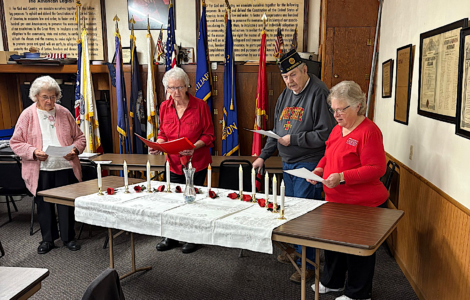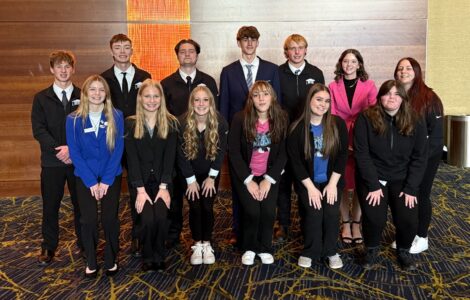Gladbrook-Reinbeck’s bond referendum headed for a recount
Recent election law changes lead to confusing string of days for county officials

A yard sign opposing Gladbrook-Reinbeck’s second try at a bond referendum photographed in Gladbrook back in November 2024. On its third try in four years, the school district successfully passed a bond referendum during the 2025 city-school election held earlier this month on Nov. 4. A recount petition of Public Measure TY was filed last week by Tama County citizen Craig Sash; the petition was accepted on Tuesday. PHOTO BY RUBY F. MCALLISTER
REINBECK – The narrow passage of Gladbrook-Reinbeck’s $17.3 million bond referendum by a mere 17 votes on Tuesday, Nov. 4, is headed for a recount.
On Nov. 13, 2025, the Tama County Auditor’s Office – the controlling county for G-R school elections – received a petition filed by Craig Sash of rural Traer requesting a recount of Public Measure TY. A total of 38 individuals, including Sash, signed the petition. All but Sash listed their residence as Gladbrook.
Iowa Code requires recount petitions for public measures be signed by “the greater of not less than ten (10) eligible electors or a number of eligible electors equaling one (1) percent of the total number of votes cast upon the public measure.” A total of 1,936 votes were cast as part of G-R’s bond referendum; 20 petition signatures were thus required.
According to Tama County Elections Administrator Jenna Cremeans, who was reached via email by the newspaper last week, G-R’s bond referendum received 1,179 votes in support of the public measure and 757 votes against. The measure required a 60% supermajority to pass, or 1,162 votes – the measure thus squeaked through with 17 votes.
This past June, Gov. Kim Reynolds signed into law House File 928, an act relating to the recounting and contesting of elections. Part of the changes affect when a recount of a public measure shall be ordered following the filing of a petition.
Iowa Code Section 50.49(1) now reads: “A recount for any public measure shall be ordered by the board of canvassers if a petition requesting a recount is filed with the state commissioner for a public measure voted on by the electors of the entire state, or the county commissioner for all other public measures, not later than three days after the completion of the canvass of votes for the election at which the question appeared on the ballot and the abstracts prepared pursuant to section 50.24 indicate that the difference between the affirmative and negative votes cast on the public measure is less than fifteen hundredths of one percent for a public measure voted on by the electors of the entire state, or less than either one percent or fifty votes, whichever is lesser, for all other public measures.”
The new language requiring a threshold for ordering a recount can seemingly be interpreted in one of two ways – 1% of the total votes cast (which would equal 19.36, or 20 votes) OR 1% of the difference between the yes and no votes (4.22 votes, or 5 votes).
On Friday, Nov. 14, Cremeans told the newspaper that the recount had been rejected based on using the latter interpretation as 17 votes is greater than five votes. She said the rejection was made using guidance directly from Iowa Secretary of State Paul Pate’s office.
When reached by the newspaper on Friday, Nov. 14, Sash provided a statement as to why he filed the petition in the first place.
“We filed the petition just to do a recount and get verification, since the vote was so close – 16 votes or .8% is what it passed by. Understanding it is an exceptionally-slim chance of success, or the recount could produce more yes votes, the thought process was to double check and verify,” Sash said. “Unfortunately the [Iowa Secretary of State] rejected the petition even though it only passed by 16 or 17 [votes], stating the vote difference was too large between yes and no votes to qualify for a recount. Personally I think that’s complete bull**** because it in effect turns the requirement of super majority to that of a simple majority. But leave it to the government to stand on taxpayer throats when they get a chance.”
In a twist, on Tuesday morning of this week, the Marshall County Board of Supervisors listed “Approve Recount for the Gladbrook Reinbeck Bond Referendum” as the board’s eighth agenda item for its regular meeting set for Wednesday, Nov. 18.
The newspaper was awaiting a response on whether or not the recount petition was going forward from both the Tama County Auditor’s Office and the Grundy County Auditor’s Office as of press time on Tuesday, Nov. 18. The newspaper also reached out to G-R Superintendent Caleb Bonjour for comment. Bonjour said he understood why the petition was filed, telling the newspaper, “When an election is decided by a small margin, accuracy and transparency are important, and a petition for a recount is one way to seek that clarity. I appreciate and respect the process. We will continue to move forward and listen to our communities as we continue the important work that lies ahead for the district.”
Late in the business day Tuesday afternoon, Cremeans told the newspaper via email the petition had been accepted in a reversal of last week’s rejection.
“It is 1% of the total vote, therefore the petition was accepted (final decision),” Cremeans said. “This was determined by the Secretary of State’s office and their attorney.”
Cremeans also provided the newspaper with a rough timeline for the recounts to take place – dependent on Sash’s schedule as, per Iowa Code, he must be present at the recounts. Tama County planned to conduct their recount this Thursday. In terms of how quickly the four counties (Black Hawk, Grundy, Marshall, Tama) must finish the recount, Cremeans said they have 18 days to do so after the petition was filed.
“We are marking today as Day 1 since there has been so much confusion,” she said.
Public Measure TY
According to the district, with the bond’s passage, the following will be addressed at the junior high/high school building in Reinbeck:
-Build a secure-entry classroom addition to improve safety and replace outdated learning spaces
-Address ADA-compliance and accessibility issues
-Complete HVAC system upgrades for safety, comfort and efficiency
-Improve electrical systems to support learning technology
-Replace deteriorating infrastructure from the 1921 building
-Create flexible, functional academic spaces to support student learning and future programming
The bond will be repaid over a series of 20 years. The tax impact will be an estimated increase of $2.70 per year on every $1,000 of taxable property value. Per the district, for a home assessed at $150,000, the estimated tax impact would be $14.92 per month; for agricultural land, the estimated tax impact would be $0.34 per acre per month.
This is a developing story.
Sun Courier Note: This story is being published online ahead of the Friday, Nov. 21 print edition of the Sun Courier in order to accommodate the Times-Republican’s publication schedule.





